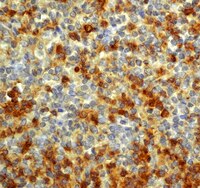Distinct TCR signaling pathways drive proliferation and cytokine production in T cells.
Guy, CS; Vignali, KM; Temirov, J; Bettini, ML; Overacre, AE; Smeltzer, M; Zhang, H; Huppa, JB; Tsai, YH; Lobry, C; Xie, J; Dempsey, PJ; Crawford, HC; Aifantis, I; Davis, MM; Vignali, DA
Nature immunology
14
262-70
2013
Show Abstract
The physiological basis and mechanistic requirements for a large number of functional immunoreceptor tyrosine-based activation motifs (ITAMs; high ITAM multiplicity) in the complex of the T cell antigen receptor (TCR) and the invariant signaling protein CD3 remain obscure. Here we found that whereas a low multiplicity of TCR-CD3 ITAMs was sufficient to engage canonical TCR-induced signaling events that led to cytokine secretion, a high multiplicity of TCR-CD3 ITAMs was required for TCR-driven proliferation. This was dependent on the formation of compact immunological synapses, interaction of the adaptor Vav1 with phosphorylated CD3 ITAMs to mediate the recruitment and activation of the oncogenic transcription factor Notch1 and, ultimately, proliferation induced by the cell-cycle regulator c-Myc. Analogous mechanistic events were also needed to drive proliferation in response to weak peptide agonists. Thus, the TCR-driven pathways that initiate cytokine secretion and proliferation are separable and are coordinated by the multiplicity of phosphorylated ITAMs in TCR-CD3. | | 23377202
 |
Impaired angiogenesis and altered Notch signaling in mice overexpressing endothelial Egfl7.
Nichol, D; Shawber, C; Fitch, MJ; Bambino, K; Sharma, A; Kitajewski, J; Stuhlmann, H
Blood
116
6133-43
2010
Show Abstract
Epidermal growth factor-like domain 7 (Egfl7) is important for regulating tubulogenesis in zebrafish, but its role in mammals remains unresolved. We show here that endothelial overexpression of Egfl7 in transgenic mice leads to partial lethality, hemorrhaging, and altered cardiac morphogenesis. These defects are accompanied by abnormal vascular patterning and remodeling in both the embryonic and postnatal vasculature. Egfl7 overexpression in the neonatal retina results in a hyperangiogenic response, and EGFL7 knockdown in human primary endothelial cells suppresses endothelial cell proliferation, sprouting, and migration. These phenotypes are reminiscent of Notch inhibition. In addition, our results show that EGFL7 and endothelial-specific NOTCH physically interact in vivo and strongly suggest that Egfl7 antagonizes Notch in both the postnatal retina and in primary endothelial cells. Specifically, Egfl7 inhibits Notch reporter activity and down-regulates the level of Notch target genes when overexpressed. In conclusion, we have uncovered a critical role for Egfl7 in vascular development and have shown that some of these functions are mediated through modulation of Notch signaling. | Western Blotting | 20947685
 |











